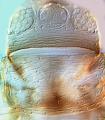Psilothrips priesneri
Recognition data
Distinguishing features
Bailey (1957: 190) stated that P. priesneri is known only from the original specimens, and also indicated that this species is "extremely close" to P. pardalotus. However, O'Neill (1960) provided a redescription and illustrated key to distinguish the two species. She pointed out that the metanotum of P. priesneri is reticulate with internal markings, and lacks the distinctive swirling concentric sculpture lines on the posterior half that are typical of P. pardalotus.
Related and similar species
The genus Psilothrips includes five species, one from India, two from the Mediterranean region and two from western USA. These species are unusual in having a pair of long setae medially on each tergite that arise from the antecostal ridge.
Taxonomic data
Current valid name
Psilothrips priesneri (Moulton)
Original name and synonyms
- Anaphothrips priesneri Moulton, 1926: 123
Family placement
Thripidae, Thripinae
Biological data
Life history
Not known
Host plants
A total of six females have been studied, from five different arid zone plant species in various families, but the breeding host is possibly Amaranthus (Amaranthaceae), or Atriplex (Chenopodiaceae).
Tospoviruses vectored
None
Crop damage
None
Distribution data
Area of origin
Western USA
Distribution
California



